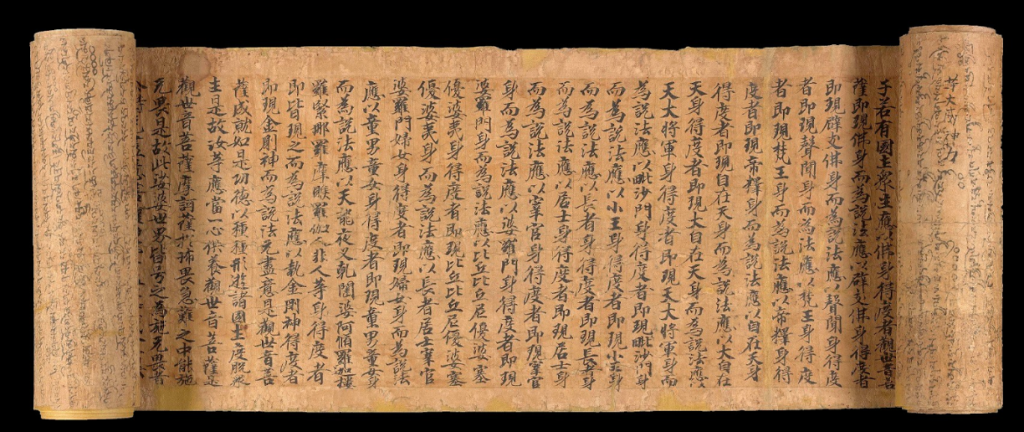Japanese Sutra Container
Japanese Sutra Container with a Chrysanthemum Design

Sutra Container with a Chrysanthemum Design
Undated
Carved bamboo with metal hinges and clasp
13.5 x 2.5 in.
Japan
1992.221
This sutra container, or kyobako, is made of bamboo. There are two metal hinges on the right, as well as a metal clasp on the left, allowing this container to securely open and close. Intricately carved designs of chrysanthemum flowers decorate the front, a flower commonly used in Buddhist offerings that is also the design of Japan’s imperial family crest. The interior of the container has been covered with gold paint, although the natural striations of the bamboo are still visible.
Bamboo was likely chosen for its strength, lightness, and flexibility. An artist working with bamboo would need to first use specialized processing techniques to protect it from insect infestations or mold. Sarashi, the term for the entire curing process, can take anywhere from a few weeks to a year.1 It includes cleaning and drying the bamboo, as well as oil removal, a process that hardens the bamboo and allows it to obtain the deep, warm golden tone seen in this object. In Japanese culture, bamboo has frequently served as a symbol of purity, resilience, and uprightness, 2 perhaps speaking to the purpose of this container in preserving and protecting the teachings of the Buddha written in the sutras.
Thus, the container serves a ritual purpose since the sutra, or Buddhist scripture which can be seen as a dharma relic, is enshrined in it. Dharma relics record Buddhist teachings and can include whole sutras or dharma verses that embody the Buddha in text.3 Because of the protection it provides, the sutra container takes an important role in the sutra transcription and burial ceremony. In Buddhism, sutras have the power of saving lives and redeeming followers. For example, according to the Lotus Sutra, followers can gain access to regards and receive salvation, such as being cured if ill. Additionally, The Golden Light Sutra ensures a country’s stability and peace.4

By transcribing such texts, people could harness the benefits, including bringing a more advantageous rebirth to a deceased loved one and lessening the anguished torment in hell after death. Participants of the sutra transcription need to ensure that all the objects involved – brush, ink, and paper – are untainted by sins. In a more rigorous process, an individual would perform five bodily prostrations after writing the first character, followed by three bows to the characters. After this ritualistic copying, the sutra would be put into a container to preserve the Buddhist teachings and show reverence for the sutra text.5 Containers like this thus serve as reliquaries and protect the sutra as a dharma relic. This Japanese sutra container is an example of how art and ritual can be intertwined.
Jessica Wu
Neuroscience and Medicine, Health, and Society
Class of 2023
Zihan Mei
Economics
Class of 2025
Annotated Bibliography
Bess, Nancy Moore, and Wein, Bibi. Bamboo in Japan. Tokyo; New York: Kodansha International, 2001.
Moore and Wein provide a comprehensive summary of the use of bamboo in Japanese culture. The authors examine the history of bamboo as a symbol, natural resource, and art material: used to make crafts ranging from baskets to lanterns to personal accessories. They aim to capture the entire process of bamboo craft making, starting from cultivation and harvest to processing and display as the final product. Hundreds of photographs of various usages of bamboo in Japan are provided as evidence of bamboo’s widespread usage and beauty.
O’Neal, Halle. “Dharma Relics in Medieval Japan.” In Word Embodied, 1st ed., 412:168–. Harvard University Asia Center, 2018.
O’Neal writes about the sutra’s central position in medieval Japanese society, making emphasis on its salvific power, social and economic cachet, and political and religious authority. The author provides information about the significance of sutra in Buddhism and the reasons why sutra can be seen as dharma relics. She also details the sutra transcription ceremony to support her arguments.
Strong, John. Relics of the Buddha / John S. Strong. Princeton, N.J: Princeton University Press, 2004.
John Strong’s book examines how relic veneration has played an important role in Buddhism, and identifies three main types of Buddha relics: body relics, contact relics, and dharma relics. He follows the life story of the Buddha, including the death and funeral, discussing the possible meanings of relics from significant events. He also talks about the legendary events related to relics, for example, the collection and redistribution of bodily relics, and traditions surrounding relics.
